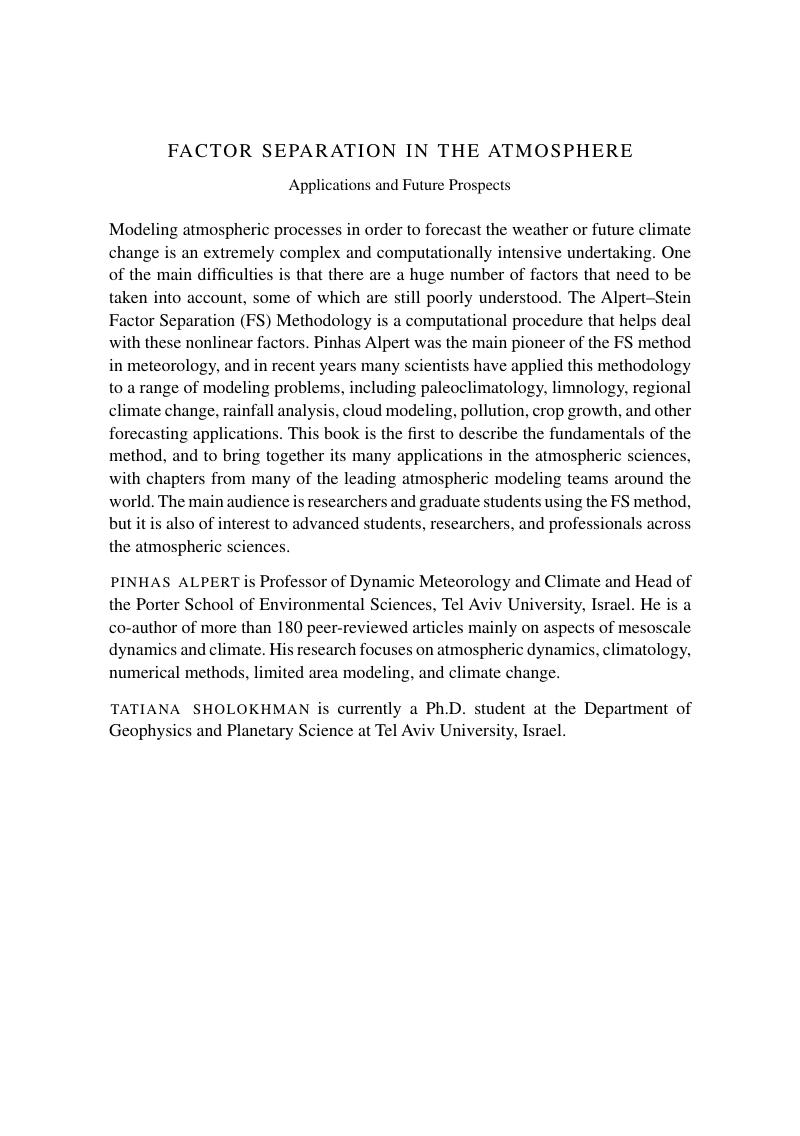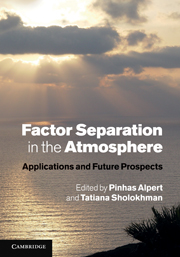Book contents
- Frontmatter
- Contents
- List of contributors
- Foreword
- Preface
- 1 Introduction
- 2 The Factor Separation Methodology and the fractional approach
- 3 Investigation of the Factor Separation features for basic mathematical functions
- 4 Factor Separation Methodology and paleoclimates
- 5 Meso-meteorology: Factor Separation examples in atmospheric meso-scale motions
- 6 Using the Alpert–Stein Factor Separation Methodology for land-use land-cover change impacts on weather and climate process with the Regional Atmospheric Modeling System
- 7 Application of Factor Separation to heavy rainfall and cyclogenesis: Mediterranean examples
- 8 Experience in applying the Alpert–Stein Factor Separation Methodology to assessing urban land-use and aerosol impacts on precipitation
- 9 Free and forced thermocline oscillations in Lake Tanganyika
- 10 Application of the Factor Separation Methodology to quantify the effect of waste heat, vapor and pollution on cumulus convection
- 11 The use of the Alpert–Stein Factor Separation Methodology for climate variable interaction studies in hydrological land surface models and crop yield models
- 12 Linear model for the sea breeze
- 13 Experience and conclusions from the Alpert–Stein Factor Separation Methodology
- 14 Tagging systematic errors arising from different components of dynamics and physics in forecast models
- 15 Some difficulties and prospects
- 16 Summary
- Appendix: References employing the Alpert–Stein Factor Separation Methodology
- References
- Index
Frontmatter
Published online by Cambridge University Press: 03 May 2011
- Frontmatter
- Contents
- List of contributors
- Foreword
- Preface
- 1 Introduction
- 2 The Factor Separation Methodology and the fractional approach
- 3 Investigation of the Factor Separation features for basic mathematical functions
- 4 Factor Separation Methodology and paleoclimates
- 5 Meso-meteorology: Factor Separation examples in atmospheric meso-scale motions
- 6 Using the Alpert–Stein Factor Separation Methodology for land-use land-cover change impacts on weather and climate process with the Regional Atmospheric Modeling System
- 7 Application of Factor Separation to heavy rainfall and cyclogenesis: Mediterranean examples
- 8 Experience in applying the Alpert–Stein Factor Separation Methodology to assessing urban land-use and aerosol impacts on precipitation
- 9 Free and forced thermocline oscillations in Lake Tanganyika
- 10 Application of the Factor Separation Methodology to quantify the effect of waste heat, vapor and pollution on cumulus convection
- 11 The use of the Alpert–Stein Factor Separation Methodology for climate variable interaction studies in hydrological land surface models and crop yield models
- 12 Linear model for the sea breeze
- 13 Experience and conclusions from the Alpert–Stein Factor Separation Methodology
- 14 Tagging systematic errors arising from different components of dynamics and physics in forecast models
- 15 Some difficulties and prospects
- 16 Summary
- Appendix: References employing the Alpert–Stein Factor Separation Methodology
- References
- Index
Summary

- Type
- Chapter
- Information
- Factor Separation in the AtmosphereApplications and Future Prospects, pp. i - ivPublisher: Cambridge University PressPrint publication year: 2011

